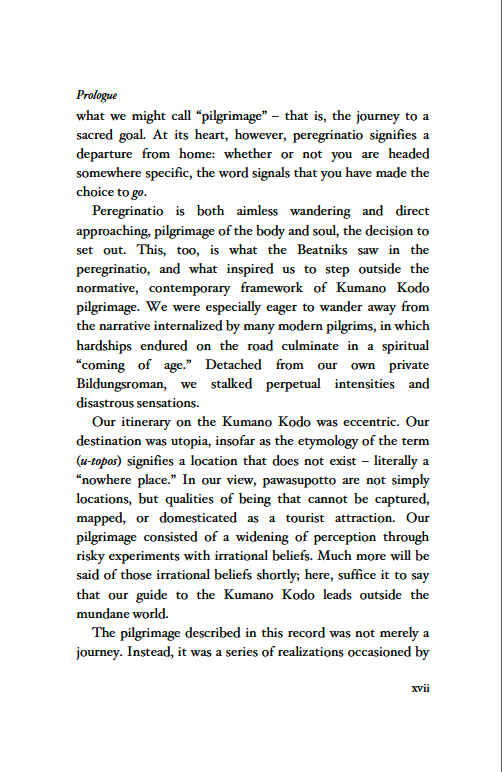Kumano Kodo: Pilgrimage to Powerspots
Kumano Kodo is a journey into the hallucinogenic power of pilgrimage. Part travelogue, part speculative fiction, part scholarly history, this book speaks to the universal human impulse to explore the sacred through travel. By focusing on Japan’s oldest pilgrimage route, the Kumano Kodo, the authors offer their readers a boldly transgressive and abundantly humorous look at the merry art of pilgrimage. Whether uncovering historical conspiracies, recounting bawdy folklore, or collecting ghost stories, this surrealist investigation establishes a new paradigm for spiritual travel inspired by an impressive breadth of scholarly research, and the authors’ many years as pilgrims across the globe. Compiled in Kyoto at the height of the pandemic in 2020, the book is a unique reflection on the unwieldy power of the sacred in times of crisis, and contains dozens of original, full-color mandalas.
Kumano Kodo was published in an edition of 100.
ISBN: 979-8-9859173-0-7
Publisher: OSGH Press
Authors: J. Christian Greer & Michelle Oing
To purchase, click here
MEDIA for KUMANO KODO
Interviews
In this discussion, Michelle and Christian share their experiences with pilgrimages, and how they came to write their book about the Japanese pilgrimage route known as the Kumano Kodo. As many may not have had their own experiences with pilgrimages, they talk about the reasons that people might choose to go on a pilgrimage, what the purpose is, and how it's not always a 'religious' thing. We also discuss the liminal aspect of the pilgrimage road, the different types of spirits that one can encounter as the pilgrim enters the 'other' space on the road, and how these encounters change the perspective of the pilgrim during the pilgrimage, but also afterwards. This conversation also includes some information about the mythology of the Kumano region of Japan, plus an interesting finding by Christian about the political side of the Kumano Kodo as a UNESCO heritage site, plus much, much more that can't be included in a short summary!
Gohar x Grail speaks with J. Christian Greer & Michelle K. Oing about their new book, “Kumano Kodo: Pilgrimage to Power Spots”. Alongside pilgrimage, we talk esotericism, walking as divination, puppetry & haunted dolls, animal ethics, St. George & sufism, Gaelic Spain & much more.
Drawing on their experiences from walking both the Camino de Santiago and the Kumano Kodo, Dr. Michelle Oing, Ph.D. and Dr. Christian Greer, Ph.D. discuss the contrast of these two UNESCO pilgrimage routes for pilgrims and look ahead to how pilgrimage may play a deeper role culturally in the years ahead.
Book Reviews
The Pilgrim Passport from the Order of St. George’s Horse
Across time and space, pilgrimage has generated an elaborate culture of documentation. The “pilgrim’s passport” is the most significant document for modern pilgrims walking the Camino de Santiago de Compostela and the Kumano Kodo.
In order to complete the Camino de Santiago de Compostela, pilgrims must present themselves to the Oficina del Peregrino in the city of Santiago, Spain, the resting place of St. James. Here, pilgrims on the Way of Santiago submit their pilgrim passport to the city’s papal bureaucracy. The document is then taken and scrutinized for any irregularities. If the pilgrim has received all the necessary stamps, the Oficina del Peregrino presents the pilgrim with the compostela, a certificate affirming that the bearer has received a partial absolution of their sins. A similar process is employed by the priestly authorities who regulate pilgrimage along on the Kumano Kodo.
Pilgrim passports can be ordered free of charge from any number of pilgrim confraternities, or purchased for a nominal fee in any of the Catholic churches in Santiago, or Shinto shrines in Wakayama. Folding out accordion-style, these documents are composed of approximately eight pages, each of which has eight squares. These squares must be filled with a stamp, dispensed by shrine-keepers, barmen, and parish priests stationed along the path. Like so many apparently mundane things, the passport itself is an immensely powerful piece of material culture that can break the thrall of the secular world.
Our pilgrimage confraternity issues its own passports, which can be downloaded as a PDF for free below. If you do end up using this passport along the pilgrimage road (in whatever continent), please do send us a message. We would love to hear your stories!
Special thanks to Shoemaker Studios for designing our passports over the years.
Poster for event (circa 2010) that led to the establishment of the Order of St. George’s Horse.
The Art of Traveling (2010)
The Art of Traveling is an anthology of essays chronicling the ideas and adventures of a small group of drifters associated with Corvid College. It was partially funded by a grant for artists in Boston, MA. The various expenses we incurred as a result of our urban explorations (including bail, court costs, and legal fees) ate up the majority of that money, though. The book is no longer available.
The Order of St. George’s Horse





















